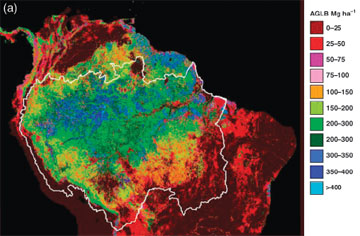Emissions from Amazon deforestation are growing as developers move deeper into old-growth forest areas where carbon density is higher, report scientists writing in Geophysical Research Letters.
Analyzing deforestation data from 2001 through 2007, a team of researchers from the Carnegie Institution’s Department of Global Ecology at Stanford University found the aboveground biomass lost per unit of forest cleared increased from 183 to 201 metric tons per hectare over the period, largely the result of moving from drier “transition” forests in the southern Amazon to wetter “rainforests” closer to the heart of the basin. Worrying, the scientists note that remaining unprotected forests harbor still higher levels of biomass — an average 231 metric tons per hectare — suggesting that future clearing will have an increasingly significant impact on climate.

Aboveground live biomass (AGLB) class map of terra firme old growth forests derived from the decision rule classifier and multiple layers of remote sensing data. ©2007 Saatchi et al |
Deforestation accounts for more than half of Brazil’s greenhouse gas emissions and nearly 20 percent of total emissions worldwide, a share larger than all the world’s cars, trucks, planes, trains, and ships combined.
Deforestation in the Brazil has declined sharply since peaking in 2004. For the 2008-2009 year, forest loss is expected to be the lowest since annual recording keeping began 20 years ago.
Last year Brazil announced a plan to reduce emissions from deforestation by 70 percent from a 1996-2005 baseline. It expects industrialized nations to help pay for the cost of forest protection.
Loarie, S. R., G. P. Asner, and C. B. Field (2009), Boosted carbon emissions from Amazon deforestation, Geophys. Res. Lett., 36, L14810, doi:10.1029/2009GL037526.














